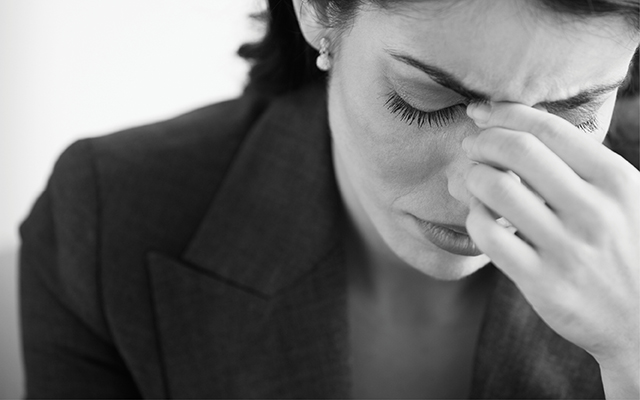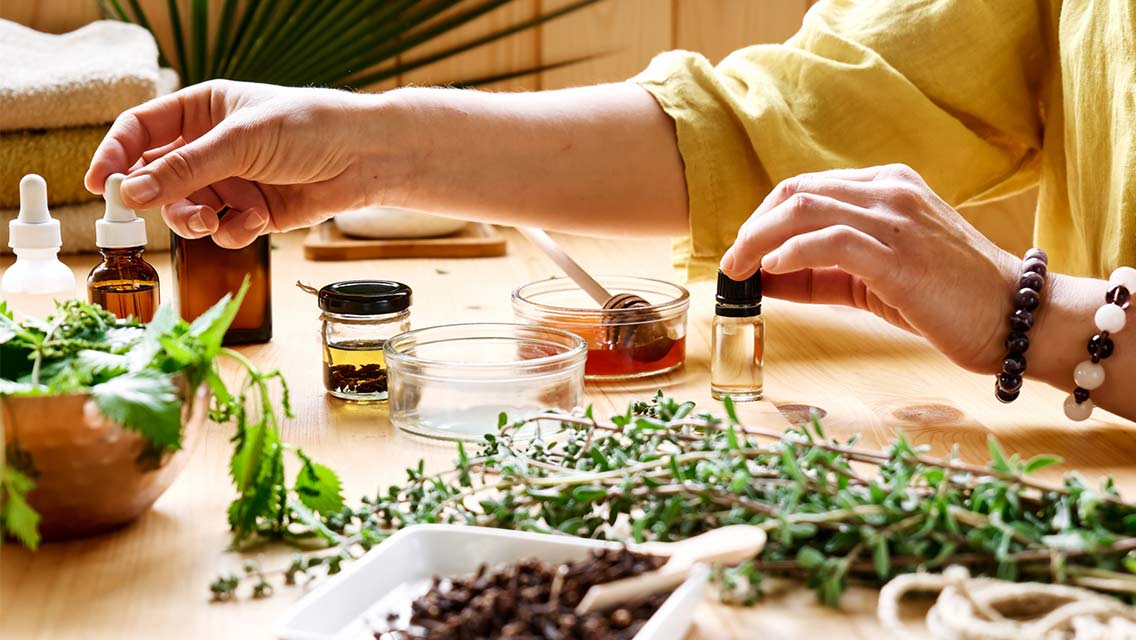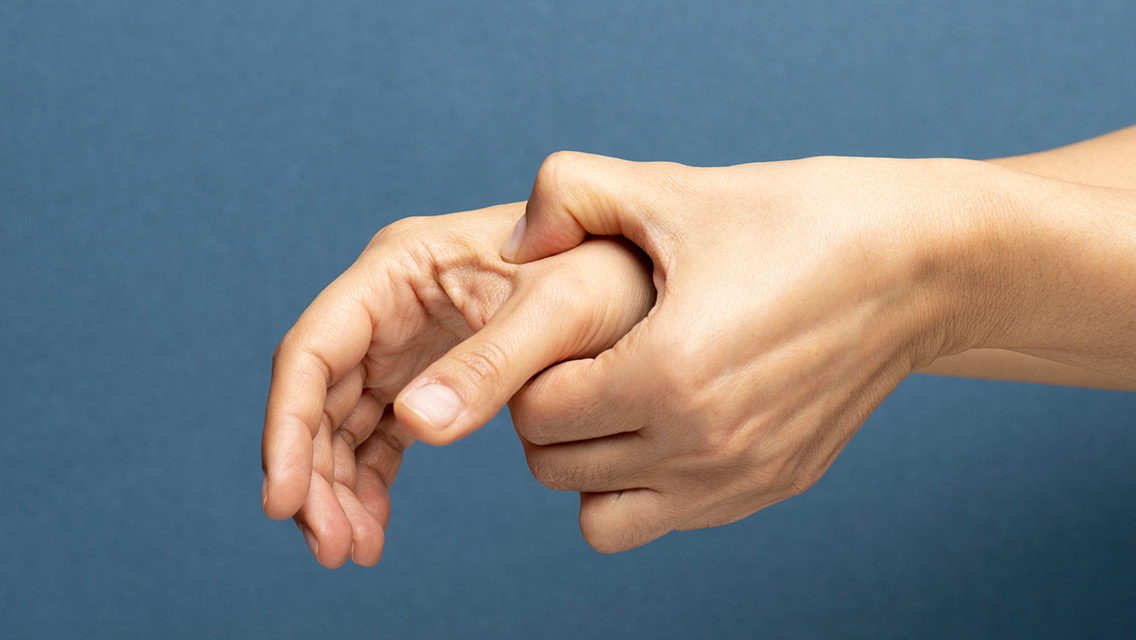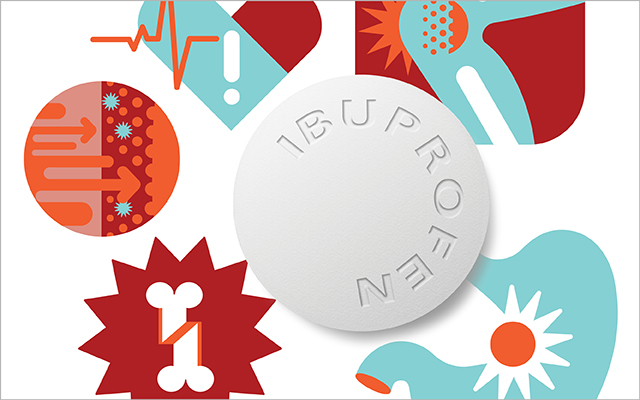Headaches might just be the most oppressive common malady there is. About 40 percent of us routinely suffer ordinary tension-type headaches, which range from the sensation of a tightening band to outright pounding around the head. Ninety-three percent have these headaches at least once or twice a year.
It gets worse for the additional 50 million Americans who endure migraines, which pulse and throb relentlessly on one side of the brain. Accompanied by nausea, dizziness, numbness, neck pain and a host of other physical symptoms — even hallucinations — migraines can be mild or can grind life to a halt for hours or days at a time. The most severe migraines keep people home, in darkened bedrooms, and unable to drive, withstand the light of day, work or care for their kids. “About 11 percent of Americans suffer especially severe headaches,” says neurologist Richard Lipton, MD, of the Albert Einstein College of Medicine in New York City. About 6 million people suffer migraines every day of their lives.
That’s a whole lot of agony, yet neurologist David Buchholz, MD, of Johns Hopkins University, believes these statistics actually understate the problem. “I often find that people who come to me for frequent, severe headaches do not even bother reporting the background headache they live with,” he notes.
Indeed, because headaches are so often dismissed as a reaction to life stress, just psychosomatic and “all in the head,” millions of Americans appear to be living with them, not seeking intervention at all.
“I have found that people tend to suffer in silence and, unless the pain is very severe, live with it every day,” says Buchholz.
Top experts hold varying points of view when it comes to the nature of headaches. For example, some experts say tension-type and migraine headaches are different animals altogether. Others say they differ in degree but not kind; provoked by the same internal mechanism, they are seen as just different points on the expanding spectrum of pain.
In the end, it doesn’t much matter. All primary headaches are triggered by irritants driving the same engine of pain — the swelling and constriction of blood vessels in the brain — but they differ from secondary headaches, those caused by injury or disease. Indeed, when a headache results from a head injury, a stroke or an infection, only treating the underlying factor can bring a cure.
About 300 different diseases include symptoms of a headache, says David Dodick, MD, a neurologist at the Mayo Clinic in Phoenix, Ariz. But primary headaches without a disease of origin are overwhelmingly more common and often more difficult to treat because they arise from hidden natural triggers — triggers that act in concert to destabilize multiple brain circuits and biochemical cascades in genetically vulnerable individuals. Complexity reigns.
“I never had any desire to become a headache specialist,” Buchholz admits. “Headache patients were frustrating, and when treated by the book, they constantly came back with more complaints. What I didn’t realize at the time was that by following conventional treatment I was inadvertently mistreating patients.”
Buchholz’s major early misstep — a treatment blunder that is still playing out with many patients to this day — was to treat after the fact.
Today, experts like Buchholz have pioneered a whole new approach. Instead of waiting until a headache starts and then treating it, they identify common dietary and environmental triggers and help patients avoid them. “It’s much harder to get rid of the headache you’ve already got than to prevent it from occurring,” he explains.
And, instead of prescribing drugs that may cause side effects — including worse rebound headaches down the road — they have found a variety of gentle, natural supplements that keep the pain at bay. (See “Natural Cures,” below.)
While drug therapy still has its place as a staple of headache treatment, the new generation of experts view this as a last resort for the most intractable sufferers, and only after other strategies have failed.
Root Causes and Triggers
To understand the new thinking on prevention and treatment, one must trace primary headaches to their root cause. Lipton says those who suffer most frequently from headaches have especially sensitive nervous systems; the blood vessels in the brain, head and neck expand and constrict more significantly when triggered by a host of factors, from certain foods to environmental irritants to life events.
Indeed, the issue is not what types of triggers are involved, but rather how many. Their impact is cumulative, and if the load rises too high, a threshold is passed and a headache (be it tension-type or migraine) takes hold. These highly sensitive people have little choice in the matter, says Lipton. It’s simply a function of genes.
Migraines result when environmental triggers exceed the threshold (the amount of stimulation the nervous system can tolerate before pain begins): Neurotransmitters, including serotonin and glutamate, are involved, activating a brain stem area called the trigeminal nucleus. This cluster of cells sends signals through the head, neck and upper back, ultimately causing inflammation of blood vessels. As blood vessels in these areas swell, they send pain signals back to the brain — causing the migraine.
“Nerves around your head are two-way streets, carrying migraine from and to the brain,” says Buchholz, who calls the migraine “a reverberating neurological loop.” The migraine is often one-sided, he notes, because the trigeminal system is bilateral, with each of the two parts controlling one side of the face and head.
A second pathway leads to neurological symptoms (for instance, visual auras), when yet a different brain circuit causes blood vessels in the brain, eye and inner ear to constrict.
“Migraine thereby generates two different forms of blood vessel misbehavior — constriction and swelling/inflammation — and these can occur either alone or in concert,” Buchholz says. “As the mechanism of migraine unfolds, it reaches a fork in the road.” It can travel down the path to headache or the path to neurological symptoms — or both paths at once.
The mechanism for a migraine, Buchholz adds, is built into the human brain. “I can only guess why nature provided us with migraine — and why its level of activity is so high in so many people,” he comments in his book, Heal Your Headache: The 1-2-3 Program for Taking Charge of Your Pain. “Maybe migraine is the remnant of a primitive reflex that once led us to seek shelter in a cool, quiet, dark cave in response to potential threats.” But even more likely, he says, is the possibility that migraines, like seizures, are a necessary evil, a byproduct of the brain’s complex structure, lacking a true purpose.
“Migraines, like seizures, may represent malfunction of the brain under stress — something we all have the capacity for,” he explains.
The problem is, the more headaches we have and the more severe they get, the harder they are to control. “Whatever we do over and over again, we tend to perfect — and that goes for the neurological signaling that causes migraine,” says Lipton.
Just as the circuits for language and music flourish as we learn Italian or play Bach, the brain’s pain pathways grow more developed as headaches recur through the years.
Translation: The earlier we act to prevent headaches, the more success we will have getting them under control.
Preventing Headache Triggers
Since it is hard to control the blood vessels once they are swollen or constricted, prevention is the headache sufferer’s friend, and for the majority of us, it’s the most effective path to a true headache cure.
Over the years, Buchholz and others have found that some of the most damaging headache triggers are foods (see “Dietary Triggers: Top 10 List,” below). The most prominent nondietary triggers include emotional stress, the hormonal fluctuations associated with menstruation or menopause, and changes in barometric pressure. But there are plenty of other culprits.
“Too much sleep can trigger a headache, as can too little sleep,” says Buchholz. So can perfumes, tobacco smoke and missed meals. Orgasms can cause headaches. So can bronchodilators used for asthma, hormone replacement therapy and drugs like Prozac, which blocks the reuptake of serotonin and increases its level in the brain.
Since those with sensitive nervous systems suffer most, consistency in life is key for them, explains Lipton. “Eat at the same time, go to bed at the same time, exercise at the same time.” For those with a low pain threshold, regular schedules and healthy routines help keep headaches at bay.
Most headache specialists agree that the best way to avoid a headache is to avoid the triggers. But since each person is so unique, those triggers vary widely from one to the next. Lipton suggests keeping a food diary to monitor what sets you off. His approach is based on common sense: “If you eat chocolate all the time and you have headaches every other day, eliminate chocolate,” he says. “If you only eat chocolate once a month, it is probably not the cause.”
The Buchholz approach is more inclusive, and far more intense. His patients start by eliminating all the culprits on his long list of potential triggers, and then, after four headache-free months, add them back in, one by one. “Food triggers are abundant, but often unrecognized,” he says. “Sometimes a trigger, like a glass of red wine, so obviously causes a headache that it stands out, but sometimes the triggers are not obvious at all.”
The complexities are rife. For instance, some food triggers can cause a headache only days later. Others, like caffeine, appear to relieve a headache but set the stage for rebound later on. “If you add back an item and headaches recur, the message is clear: Stay away from it,” says Buchholz. “If you add back an item and maintain headache control, so far so good.”
Next-Step Interventions
It’s not always possible to avoid headache triggers. “Some people are so sensitive that even just bending over can trigger a migraine,” says Buchholz. For this group, a series of stepped interventions have helped. While a visit to your general practitioner may elicit a prescription for the big-gun pharmaceuticals — triptans like Imitrex or opioids like Ultram — many neurologists say this option should be considered only as a last resort.
Buchholz, for one, feels such painkillers can make headaches worse over time. “If used more than two days a month, these drugs create a rebound state, pushing the threshold for triggers lower. For instance, triptans, the most widely used migraine drugs, work by binding to serotonin receptors, causing blood vessels to constrict. With swelling thus suppressed, the migraine is kept at bay — for a time. The problem is that as the drug wears off, the blood vessels swell even more than they did in the first place. Once the headache “rebounds” in the brain, subsequent migraines are even more painful than the original.
That’s why, hoping to avoid this tragic cycle, many headache specialists now try to prevent the pain before the migraine begins. One such practitioner is neurologist Alexander Mauskop, MD, director of the New York Headache Center. After eliminating known triggers, Mauskop suggests a variety of supplements for daily use: These include riboflavin (vitamin B2), magnesium, butterbur and coenzyme Q10. (For more on supplements, see “Natural Cures,” below.)
Activity is another intervention: Aerobic exercise for 20 to 30 minutes a day gets the endorphins going, and these block the biochemical cascade that leads to a migraine headache, Mauskop says.
Acupuncture can banish headaches or reduce their frequency. In the largest study to date on the technique, German researchers used acupuncture to treat 15,056 patients with either tension-type headache or migraine. The results, published in the journal Cephalalgiain 2008, showed marked clinical improvement compared with routine care alone. Another study, at Memorial Sloan-Kettering Hospital in New York, found that 12 acupuncture treatments over a period of three months reduced migraine frequency, on average, from 38 days a year to just 12. Still other studies found acupuncture worked as well as the migraine medicines sumatriptan and metropol (a beta blocker).
Because stress is a common trigger (causing expansion of the blood vessels, which causes headaches), all forms of relaxation, including deep breathing, meditation and biofeedback, appear effective in minimizing its vessel-disrupting effects. With training in special relaxation techniques, individuals can learn to progressively relax their muscles, reducing headache frequency and severity by between 45 and 60 percent, notes Gay Lipchik, PhD, of the Headache Treatment and Research Project at Ohio University.
When other treatments fail, Mauskop reports that injections of botulinum toxin (Botox) — typically administered into the areas of pain, such as the forehead, temples and the back of the head — work in up to 70 percent of patients. Controlled trials suggest that intermittent and chronic migraines, as well as chronic tension-type headaches, may respond to these injections, which “inhibit the nerve endings that begin the process of sending the migraine signal to the brain,” Mauskop explains. “The effect of a single treatment, which is technically simple to administer, usually lasts three months.” It’s a controversial approach, but a number of large, controlled clinical trials are currently under way.
Doctors like Dodick teach patients to recognize the symptoms that can precede a migraine, such as peculiar visual symptoms, yawning, increased urination, nausea, even diarrhea. The sooner in the cycle the migraine is treated, he notes, the easier it is to control. But sometimes only drug therapy can help.
“There are those who suffer pain every second of every day, and those with such sensitive mechanisms that life itself is a trigger,” he says. In the face of this severe disease, Dodick, Lipton and others say pharmaceutical medicines are lifesavers, side effects and all.
But, given the potential for rebound headaches when drugs are stopped, doctors envision a nondrug future. Deep brain stimulation, for instance, is strictly experimental right now, but some clinical results suggest that, when nothing else works, using an electrode to stimulate the posterior hypothalamic neurons might inhibit or even eliminate chronic intractable headache pain.
Others mention vagus-nerve stimulation. In a clinical trial reported in the journal Cephalalgia, Mauskop and his team implanted stimulators at the site of the vagus nerve (which travels from the brain stem through organs in the neck, thorax and abdomen) in four men and two women with disabling chronic migraine and (much less common) cluster headaches. In one man and one woman with chronic migraines, vagal-nerve stimulation produced dramatic improvement and even restored their ability to work. Two patients with chronic cluster headaches reported significant improvement as well, making this an option when other treatments fail.
Look for large studies in the future, Lipton says — but given the invasiveness of the technique, the majority of sufferers should first try natural products like magnesium and butterbur (see “Natural Cures,” page 62) or prescription drugs with proven efficacy.
Buchholz adds that sufferers must beware. “Conventional falsehoods about headaches have been institutionalized” for so long, he says, that “most headache sufferers simply accept standard answers from their doctors while blaming themselves for their pain.”
It doesn’t need to be that way. A perfect cure for headaches may not be within our grasp anytime soon. But by embracing the wide range of treatments available now — from avoiding triggers and taking supplements to trying medical interventions when warranted — all but the most intractable headaches can be controlled.
Easy Fixes Worth Trying
- Avoid caffeine drinks and chocolate.
- Eliminate diet soda and other products with aspartame.
- See an acupuncturist.
- Try biofeedback.
- Eat breakfast and schedule regular meals.
- Stop wearing perfume and avoid scented products.
- Don’t oversleep or undersleep.
- Stay away from MSG (monosodium glutamate) — and remember that many diet products are loaded with it.
- Get regular aerobic exercise.
- Check your home for fumes.
- Embrace stress-management techniques like yoga, meditation or deep breathing.
- Identify and eliminate food to which you have intolerances or sensitivities.
Dietary Triggers: Top 10 List
- Caffeine. Found in coffee, tea, colas and certain other sodas. Going off caffeine suddenly can also trigger headaches.
- Chocolate. Anything with cocoa. Chocolate contains phenylethylamine, which may cause blood vessels to expand and contract.
- Monosodium glutamate. Famously found in Chinese food, but also in seasoned salt, salty snacks, prepared soups, many low-fat and low-cal foods, and even veggie burgers. Steer clear of hydrolyzed vegetable, soy or plant proteins, which can contain similar compounds.
- Nuts. From almonds to pistachios, they can all be culprits, as can nut butters.
- Deli meats and fish. If it has been aged, canned, cured, fermented, marinated, smoked or tenderized, it may trigger headaches, says Buchholz. Preservation with nitrites or nitrates is a no-no. Avoid beef livers and chicken livers, as well.
- Dairy products, especially cheese. This includes all kinds of hard cheeses and foods prepared with cheese. The more aged the cheese, the worse the trigger. White cheeses, including cottage cheese, ricotta and cream cheese, have not been implicated, but yogurt has.
- Red wine. Too much red wine or any dark alcohol can stack the decks against you. Of all drinking alcohols, vodka is tolerated best. Also avoid vinegar; balsamic is the most problematic, but white should be OK.
- Certain fruits and vegetables. In his book Heal Your Headache, Buchholz lists the fruits and vegetables most implicated in triggering headaches. Among the problematic fruits: citrus fruits and fruit juices, bananas, raisins and other dried fruits preserved with sulfites, raspberries, red plums, papayas, passion fruit, figs, dates, and avocados. Vegetable culprits include sauerkraut, pea pods and beans (from fava to navy to lentils). The worst vegetable offender may be onions, though baby onions are OK.
- Freshly baked breads risen with yeast. Especially problematic is sourdough. Also look out for bagels, doughnuts, pizza dough and soft pretzels less than 24 hours out of the oven.
- Aspartame. Found in many diet soft drinks and artificial sweeteners, aspartame contains excitotoxins known to affect nerve cells.
Natural Cures
Eager to prevent your headaches before they start? These are the top five most effective and scientifically validated supplements:
- Riboflavin, otherwise known as vitamin B2. Two hundred milligrams of B2 twice a day has been shown to help a significant subset of patients with migraines, says neurologist Richard Lipton, MD, of the Albert Einstein College of Medicine in New York City. The key to success, experts say, is taking the vitamin every day, whether you have a headache or not.
- Butterbur, a root extract from the plant Petasites hybridus. Researchers compared butterbur with a placebo in 245 headache patients. Over the course of four months, migraine attack frequency was reduced by 68 percent for those receiving 75 milligrams of the supplement twice a day.
- Magnesium. Crucial for many cellular processes. When magnesium is deficient, a headache may result. Numerous studies show that patients taking magnesium supplements have significantly fewer migraine attacks, lose fewer days to pain, and can greatly reduce the amount of medication they take for migraines. Neurologist Alexander Mauskop, MD, director of the New York Headache Center, recommends daily doses of up to 600 milligrams. (This mineral is one of the most critical nutrients in your diet. See “Magnesium: Your Body’s Spark Plug” for more.)
- Coenzyme Q10. European researchers compared migraine sufferers treated with this antioxidant with a placebo group. After three months of treatment, half of the migraine patients had fewer attacks and less nausea than the control group. The recommended dose is 300 milligrams, three times a day. (Learn more at “CoQ10: The Miracle Molecule“.)
- Feverfew, made from the plant Tanacetum parthenium, has long been used for headaches. The active ingredient, parthenolide, prevents blood vessel constriction, a leading cause of headaches. At the same time, parthenolide inhibits two headache triggers implicated in the inflammatory process: arachidonic acid and prostaglandins. Mauskop recommends a dose of 100 milligrams, taken up to four times a day.
Not every supplement will work for every patient, notes Mauskop. He recommends mixing these preventives for the best effect. Though the formula varies by patient, his favorite supplement cocktail tends to include 50 milligrams of feverfew, 200 milligrams of riboflavin, 150 milligrams of coenzyme Q10 and 200 milligrams of magnesium, taken twice a day with food. As with any treatment regimen, you should consult with your healthcare provider before proceeding.
This article originally appeared as “How to Handle Headaches.”




This Post Has 3 Comments
[…] “A trigger point is an area of tightly contracted muscle tissue,” says Albert Moraska, Ph.D., a researcher focused on complementary medicine at the University of Colorado in Denver. “Trigger points in the shoulder and neck refer [relay] pain to the head. By reducing the activity of trigger points, we can reduce headaches.” […]
[…] “A trigger point is an area of tightly contracted muscle tissue,” says Albert Moraska, Ph.D., a researcher focused on complementary medicine at the University of Colorado in Denver. “Trigger points in the shoulder and neck refer [relay] pain to the head. By reducing the activity of trigger points, we can reduce headaches.” […]
[…] “A trigger point is an area of tightly contracted muscle tissue,” says Albert Moraska, PhD, a researcher focused on complementary medicine at the University of Colorado in Denver. “Trigger points in the shoulder and neck refer [relay] pain to the head. By reducing the activity of trigger points, we can reduce headaches.” […]